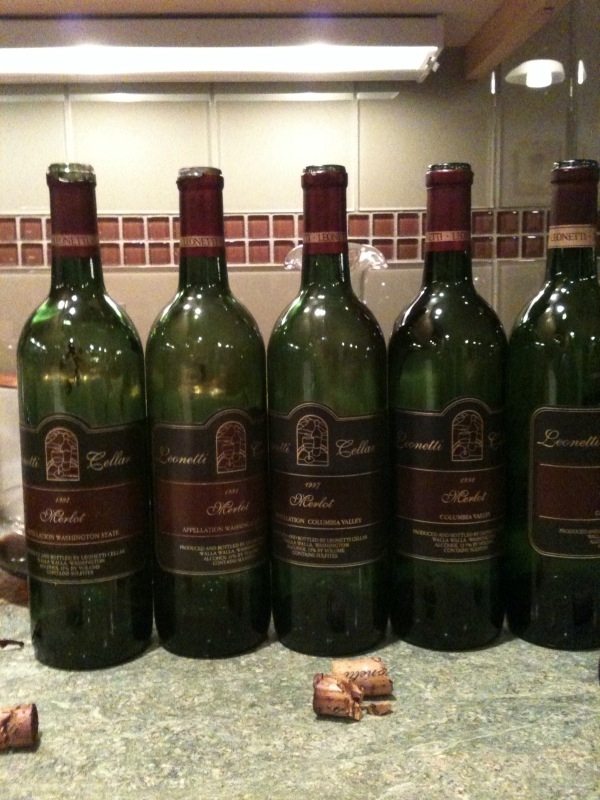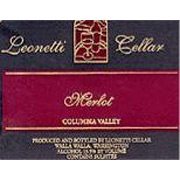 In the late 1980’s before the Walla Walla Valley appellation blossomed into more than 100 wineries farming over 1,800 acres of vineyards in a particularly dry region blessed with extended growing seasons, pioneers Gary Figgins and Rick Small slipped onto my developing list of world class winemakers. I made sure their releases beat regular paths to my cellar. Figgins’ Leonetti and Small’s Woodward Canyon Cabernets and Merlots were attention grabbers, showing classic varietal structure while consistently paying homage to the Valley vineyards’ unique terroirs that produced well structured and luscious, rich, black and red fruited wines tinged with mocha and cocoa aromas that became familiar uniforms for these dignified young wines . Leonetti produced its first wines in 1978 as Walla Walla’s only winery, and while Figgins’ wines were fit rewards for even the most discriminating hedonist, there was a total absence of any empirical evidence supporting a bottle aging strategy for enthusiasts lured to this fringe Northwest AVA.
In the late 1980’s before the Walla Walla Valley appellation blossomed into more than 100 wineries farming over 1,800 acres of vineyards in a particularly dry region blessed with extended growing seasons, pioneers Gary Figgins and Rick Small slipped onto my developing list of world class winemakers. I made sure their releases beat regular paths to my cellar. Figgins’ Leonetti and Small’s Woodward Canyon Cabernets and Merlots were attention grabbers, showing classic varietal structure while consistently paying homage to the Valley vineyards’ unique terroirs that produced well structured and luscious, rich, black and red fruited wines tinged with mocha and cocoa aromas that became familiar uniforms for these dignified young wines . Leonetti produced its first wines in 1978 as Walla Walla’s only winery, and while Figgins’ wines were fit rewards for even the most discriminating hedonist, there was a total absence of any empirical evidence supporting a bottle aging strategy for enthusiasts lured to this fringe Northwest AVA.
When Spokane’s Josh Wade (@nectarwine) suggested I give online tasting a fair try by participating in #WAMerlot this past week, I jumped at the chance to organize a short vertical tasting of five Leonetti Merlots including 1992, 93, 97, 98, and 2002 to see how the wines were handling their 8-18 years in my cellar. I invited Dale, Amanda, and Malcolm (who donated the 1992 vintage to the cause) to help me simultaneously discover the attributes of (1) tweeting and tasting, and (2) Leonetti and cellaring.
The tweeting thing was fine, making new Twitter friends who were long lost or never discovered fringe wino brethren that also succumbed to the unheard of Walla Walla AVA and Leonetti Cellars almost 20 years ago, when twittering was nothing more than the trembling hand shaking motions that occurred disgorging corks from old bottles of classic Bordeaux. I was glad to have followed Josh’s nudge, but to also have my in-person tasting group at the table to protect the human connection that lives somewhere near the center of my dedication to wine appreciation. But, there were lots of #WAMerlot folks that related to the joyous appreciation of our short vertical Leonetti tasting experience. Admittedly, it was difficult to keep up with the online tasters’ experiences with Washington Merlot with such a compelling lineup in the glassware stretched out in front of me.
 We decanted the wine an hour before tasting. The general good news is, except for the 2002, all the wines were improving in the bottle. The 1998 is a mind blowing wine and in a separate league from the rest, a very special vintage in Walla Walla, and the year’s Leonetti Merlot has at least another decade or two of befitting bottle age ahead of it. It is a wine I would seek out at auction. The 1997 took an additional hour in the glass to really show what it was made of, and it is another classic but totally different wine than the 1998. The 92 and 93 provided the good rewards of bottle age, and showed attractive advanced flavoring and aromas, with the 1993 considerably better than the still interesting, but somewhat less lively, 1992. Both corks on these two older wines showed evidence of slight leakage, but neither wine suffered from flaws of oxidation or cork damage.
We decanted the wine an hour before tasting. The general good news is, except for the 2002, all the wines were improving in the bottle. The 1998 is a mind blowing wine and in a separate league from the rest, a very special vintage in Walla Walla, and the year’s Leonetti Merlot has at least another decade or two of befitting bottle age ahead of it. It is a wine I would seek out at auction. The 1997 took an additional hour in the glass to really show what it was made of, and it is another classic but totally different wine than the 1998. The 92 and 93 provided the good rewards of bottle age, and showed attractive advanced flavoring and aromas, with the 1993 considerably better than the still interesting, but somewhat less lively, 1992. Both corks on these two older wines showed evidence of slight leakage, but neither wine suffered from flaws of oxidation or cork damage.
All of these wines have retained evidence of their signature youthful tell-tale profiles, but have advanced (again, except for the 2002) to places I once reserved in my mind for great old wines of Pomerol and Graves. We did notice that the wines of the early 90’s had 13% alcohol content and the more recent ones climbed to 13.6%. Each year the Leonetti Merlot includes some varied blended quantities of Cabernet Sauvignon, Cabernet Franc, and/or Petit Verdot while the younger vintages also include some Sangiovese (which the winery started offering as a bottled varietal sometime in the late 90’s) and Carmanere. I am curious what is driving the increased alcohol content in the later vintages.
Leonetti Cellars Merlot: My Tasting Notes:
- 1992-Slight cork leakage but firm pull from the bottle with noticeable pop, evidence of brown coloration on the edges, old cedary nose, dusty cocoa-cherry mixing with Schezuan peppercorn spice…a sweet and elegant wine with old Pomerol bones but just slightly beginning to dry out as it has achieved full maturity
- 1993– Cork leakage and less snug than the 92, aromas of dust, mushroom, sweet cherry fruit with a velvet mouthfeel, lovely long finish, advanced aromas and flavors from beginning to end. More fruit stuffing in evidence than the 1992. A classically developing old wine with time ahead of it.
- 1997: Deep purple in color, a nose of chocolate covered cherries, rich odors of Hong Kong harbor or an Asian
 spice market, and tobacco leaf, the wine took time in decanter and glass to open and show this amalgam of glorious perfume elements preceding its rich mouthfeel and extended delicious finish. It was the most exotic wine of the line up and one to cherish, but only after long periods of aeration.
spice market, and tobacco leaf, the wine took time in decanter and glass to open and show this amalgam of glorious perfume elements preceding its rich mouthfeel and extended delicious finish. It was the most exotic wine of the line up and one to cherish, but only after long periods of aeration. - 1998– A completely monumental wine and hands down, at the head of this amazingly talented class of wines. Purple all the way to the edge without and visual sign of age, raw meat and butcher shop, spicy Asian notes, and a sweet rich black cherry nose, the wine is magically knitted together in complete balanced harmony and offers a complexity of flavor and sensations that is only found in the finest wines. If there are better wines in the world made from Merlot, I can only imagine they are sourced from the finest vineyards and producers in Pomerol
- 2002– Vanilla and essence of butter dominate the nose, a one dimensional wine in comparison to the rest of the line up. Dale thought it reminded him of his Grandmother’s mashed potatoes, and I get that by adding the butter aromas to a spud-like raw aroma quality. This wine has not improved in any way that has made the wine more enticing over its 8 years and it does not appear to have the components or balance to impress any time sooner or later.
It was a very special tasting opportunity. Besides the one wine Malcolm brought, all the wines are part of the Leonetti collection that sits in my cellar but ends in 2002. Why did I stop buying the wine? I was on the mailing list, which was really the only way to get the wine on the east coast, and after buying wines for 10 years, every year, Leonetti kicked me off the list somewhere around 2004 because I failed to buy one vintage, and they replaced me with someone on their long waiting list!! On one level I understand this, but on most levels I find it appalling, disgraceful, and insulting to a customer that had bought consistently for so many years. And who LOVES the wine. I have no access to these wines anymore and that’s a shame. The good news, though, is this year when the wine industry is suffering its first soft period after so many years of growth, I cleared the Cayuse and Quilceda Creek waiting lists after enough years of waiting that I forgot I ever applied. In 15 years from today, I hope to be able to post on the progress of those excellent Washignton State wines.
P.S. Amanda brought a bottle of 2007 Chateau St. Michelle Indian Wells Merlot to taste. It was fruit bomb wine that was black purple, a little tobacco and spice on the nose, a rich full mouthfeel, but highly extracted and oaked. I could have mistaken the wine for an Aussie Shiraz on alocholic steroids. Some will like it, but it belonged in a different pack of competitors than these elegat and classy Leonettis.
P.S.S The big difference: I can buy the CSM Indian Wells easily for $17 but can’t even use 10 years of customer loyalty and $100 to snag a current release Leonetti no matter how hard I try!
